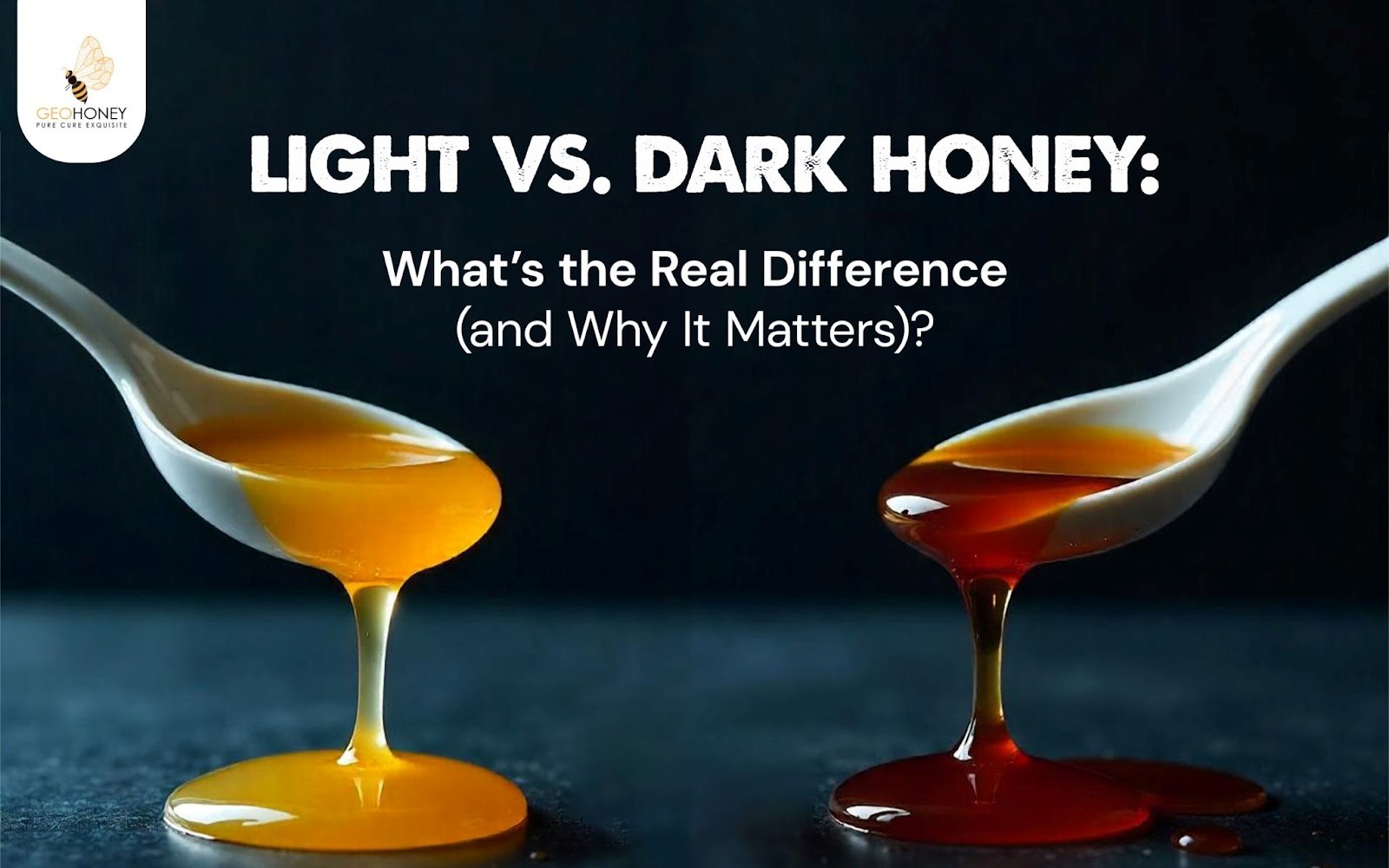- Tokyo: 11:36
- Singapore: 10:36
- Dubai: 06:36
- London: 02:36
- New York: 21:36
Light vs. Dark Honey: What’s the Real Difference (and Why It Matters)?

Honey is available in a variety of colors, ranging from very light transparent to very dark amber. This difference in honey’s color is accompanied by a difference in its taste, texture and even nutritional content.
According to Mr. Basem Barry, the founder of Geohoney and the CEO of B A Barry Group
“Honey’s color is a clear indication of its quality and flavor, which is why you need to consider this important factor when buying raw honey from any source.”
But what exactly is the difference between light and dark honey? And why does this difference matter? This is a question that often bothers honey lovers all over the world.
This blog tries to answer this question in detail. So, keep on reading till the end to learn about the real difference between light and dark honey.
What is Dark Honey?
Benefits of Dark Honey
What is Light Honey?
Benefits of Light Honey
The Origins of Honey’s Color
Light Honey vs. Dark Honey: Why the Difference Matters
Flavor
Nutritional Value
Water Content
Applications
What is Dark Honey?
Dark honey is characterized by its brown to dark amber hue, thicker texture and a slightly bitter robust flavor profile. Apart from boasting a rich flavor, this honey also contains nutrients, antioxidants, vitamins and several other healthy components in slightly greater concentrations than light honey.
Some popular varieties of dark honey include
Avocado honey: This honey comes from the nectar that bees collect from the blossoms of the avocado trees. The avocado honey is known for its molasses-like texture and buttery taste.
Buckwheat honey: This is an ultra-dark honey with a strong flavor that leaves a lasting aftertaste.
Chestnut honey: This brownish honey has a thick texture with a mildly sweet flavor.
Manuka honey: A speciality of New Zealand, this honey has a dark, creamy texture. It features a bold flavor with notes of caramel.
Benefits of Dark Honey
Following are a few benefits of dark colored unprocessed honey
It has higher concentrations of antioxidants like flavonoids, phenols, etc., compared to light honey.
This honey type has superior antibacterial activity.
This honey possesses anti-inflammatory properties.
It regulates blood cholesterol, which promotes heart health.
This honey contains minerals like zinc, iron, calcium, magnesium and sodium, which boost immunity.
It helps you fight seasonal allergies and illnesses like the flu and common cold.
What is Light Honey?
This type of honey is known for its water white to very light amber hue. Compared to darker honey, light honey has a milder color and sweet taste. This honey is rich in vitamins and its antioxidant contents make it an effective ingredient in remedies for skincare, the common cold and flu.
Some popular light honey varieties are
Wildflower honey: This honey comes in a wide range of colors from water white to creamy and light amber. Wildflower honey has a mild floral flavor that goes well with most baked goods.
Orange Blossom honey: This honey has a light amber hue with a sweet and floral taste.
Sage honey: This rare honey variety comes in a pale white color. It has a low moisture content and a slow crystallization rate. Sage honey has a flavor that is a mix of fruity and spicy notes.
Benefits of Light Honey
Following are some benefits of white honey that you need to know
This honey has a low Glycemic Index, which means you can consume it without a rise in your blood sugar levels.
It contains antioxidants, nutrients and vitamins in sufficient amounts.
It has wound healing, antimicrobial, antibacterial and anti-inflammatory properties.
It is effective for soothing a sore throat and reducing other flu symptoms.
It increases metabolic activity, which leads to better weight management.
It enhances gut health by promoting the growth of healthy bacteria, which reduces bloating, constipation and other gastrointestinal illnesses.
The Origins of Honey’s Color
Honey has hundreds of varieties and each has a unique flavor, color and other defining features. The color of the honey mainly depends on the flowers that bees forage on.
There are some flowers whose nectar contains very minute amounts of pigments, which leads to a honey that has a nearly clear to light amber color. On the other hand, floral sources like buckwheat and chestnut produce darker honey as their nectar has a darker composition.
The botanical origin of the honey is thus the main factor that decides its color, nutritional profile and flavor.
Following are some other factors that can influence honey’s color
The storage time and exposure to heat significantly affect its color. Crystallized honey has a lighter color while honey exposed to higher temperatures has a darker color.
The season in which honey is harvested can also affect its color. Honey collected in spring from acacia and clover flowers is usually light-colored. Honey harvested in autumn has a darker hue. Summer honey made from chestnut or wild blackberry sources tends to be yellow or light amber colored.
Light Honey vs. Dark Honey: Why the Difference Matters
The following points throw some light on why the color difference of the organic honey matters.
Flavor
The color of the honey tells you a lot about its flavor. Lighter honey tends to have a subtly sweet and mild flavor. Darker honey varieties are rich in sweet sugars, and their flavor can be best described as bold, robust and earthy.
Nutritional Value
Both light and dark honey types have almost the same amount of nutrients. The darker honey has some extra antioxidants and minerals as it is minimally filtered and processed in most cases.
Water Content
Dark honey has less water content, which is what makes it more concentrated and robust in terms of color and flavor. The water content of light honey is more in comparison which gives it a mild taste and slightly thinner texture.
Applications
Dark honey is an important ingredient in gourmet recipes. It is also a part of the everyday diet for athletes and people looking to eat healthy.
Light honey is mostly used in baking recipes and for sweetening beverages as it doesn’t overpower their flavors or textures.
Conclusion
When buying honey, you need to carefully look at its color and consider what it means. Darker honey varieties tend to be more flavorful, less processed and more nutritional.
Light honey, on the other hand, has a mild flavor with fewer antioxidants. However, it is still an effective alternative to processed sugars as it has a low Glycemic Index.
The choice between light and dark honey has more to do with your personal taste preference or recipe requirements. Both of these honey types have their unique features and benefits that make them useful in their own way.
You can visit us at Geohoney to buy the best quality monofloral dark and light honey varieties that give you an amazing flavor with countless health benefits.



